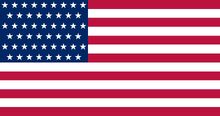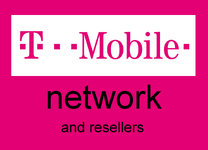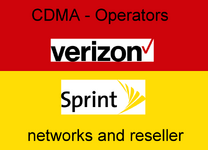
The US does a lot of things differently: voltage, plugs and the mobile (here often called: cell[ular]) phone system too. This leads to a lot of errors and confusion when you come from a different part of the world. Here is a short guide to avoid disappointments.
Territory
This article applies to the United States of America (USA), its 50 states and the District of Columbia. It's valid for all of the continental mainland and the islands of Hawaii. There, the same operators are on the air forming one common network without roaming fees. This is partly true for Puerto Rico and the US Virgin Islands too, but additional operators offer mobile services there shown in an own Puerto Rico article. Other US overseas territories where different providers run are featured in seperate articles like these of Guam or Samoa.
Networks
The USA has 4 national mobile networks:
- Verizon Wireless
- AT&T
- T-Mobile US
- Sprint
This is added by small regional networks operating in limited areas. Through domestic roaming agreements they are partly available to customers of the big 4 providers too (for details see Domestic Roaming in the United States).
- in 2G Verizon and Sprint both use CDMA, while T-Mobile uses GSM
- in 3G Verizon and Sprint both use EVDO, while AT&T and T-Mobile UMTS based technology
- in 4G all four operators employ LTE technology only
CDMA- vs. GSM-based networks
In the US two different mobile network systems operate which are not compatible until 4G on LTE has arrived. The CDMA technology is used in very few countries of the world like Japan or China. But in the US it's employed by the two major operators Verizon and Sprint. You could easily identify them by the non-detachable SIM card, but this has changed now for LTE. Still, the device needs to be activated on the network and will be 'married' with the provider from then on with hardly any way to change. You can still buy a CDMA phone or modem, but you can use it only on their network in the US and nowhere else.
The big advantage of GSM-based technologies is that the SIM card of (unlocked) devices can be taken out and changed to one of another operator and country. This what this Wiki is all about. Only GSM technology enables you to perform the procedures described here and GSM is the only mobile technology used in 98% of the world's countries. That's why it's assumed that you are a GSM device holder and the rest of this article is about GSM-based technology. This leaves you with a rather limited choice in the US as only two (physical) cellular networks and their resellers support GSM and its advancements: AT&T (in 3G only) and T-Mobile US (in 2G and 3G).
Slowly the gap between CDMA and GSM narrows as the same LTE technology is now used by both system lines for 4G. CDMA-operators now sell "world phones" with a SIM card slot working in GSM networks outside of the US. Otherwise, GSM-device owners still have a very restricted access to CDMA networks as shown in this sub-article "CDMA in the US". For the rest of this article here we stick to GSM.
AT&T vs. T-Mobile US network
This is a very tricky one. You can count yourself lucky that you still have the choice as some years ago T-Mobile US was to be sold to AT&T but this was rejected by anti-trust authorities. Superficially, it’s an easy call. AT&T has more than twice as many customers and still the better nationwide coverage on 3G and 4G. But T-Mobile has focused on the big cities giving better speeds there combined with very aggressive pricing well below the rates of AT&T. T-Mobile is the only 2G provider now and the 4G coverage gap to AT&T is narrowing.
Compatibility and frequencies
To really work out the differences you have to compare the frequencies of your device with the frequencies offered by AT&T and T-Mobile as there are a lot of incompatibilities with devices from out of the US. For major phone models it's shown here how to check it. Have in mind that some models with the same name are sold in different versions in the US and Europe/Asia,
2G/GSM (GPRS, EDGE)
For 2G you should have a phone that supports 850 and 1900 MHz bands. From Europe or Asia a tri- or even better a quad-band phone does this. AT&T has shut down its 2G network nationwide on January 1st, 2017. So T-Mobile remains the only player. For T-Mobile you need to have at least 1900 MHz as it's their primary frequency.
On 2G you can only get EDGE with slow data speeds up to 200 kbps. If you want to use 2G on roaming like in dual-SIM phones, be sure that your roaming partner supports T-Mobile in the US or you will be shut out. For instance many Vodafone networks from Europe only roam on AT&T and thus now in 3G or 4G-only.
3G/UMTS (HSPA+, DC-HSPA+)
Now it’s getting complicated: AT&T has a good (though sometimes slow) coverage on 850 MHz and 1900 MHz up to HSPA+ (= 21 Mbps) speed. In most markets they use both bands with aggregation for extra speed, but in some states they have licences for just one of them. When checking frequencies on your device, be aware that 1900 MHz on 2G doesn't automatically mean, that it's on the same band on 3G.
T-Mobile used to operate 3G on the 1700 MHz (= AWS) band only. This was (almost) the only operator in the world on this frequency, so hardly any non-T-Mobile US phone could cope with it. AWS is sometimes referred as “1700/2100” MHz suggesting a 2100 MHz phone would work. This is misleading as AWS is using the 1700 spectrum for uploading and 2100 for downloading and can’t be handled by a 2100 MHz-only device.
Luckily, T-Mobile changed the game when it acquired new frequencies in 2012. They were now shifting (or “refarming”) the most of their 3G spectrum from 1700 AWS to 1900 MHz (= PCS band). This gives much better compatibility with lot of devices like the iPhone. In 2014 the refarming has been completed and 1900 MHz HSPA+ (up to 21 Mbps) coverage is now in most markets, but a few rural areas.
T-Mobile shut down 1700 AWS in some of these markets in 2015 and keeps on shifting more markets from 1700 MHz AWS to 1900 MHz PCS on 3G. In markets where 3G HSPA+ is offered on both 1700 MHz and 1900 MHz, T-Mobile offers DC-HSPA+ at speeds up to 42 Mbps on devices that support both, which is mostly only US-sold phones. So in 2016 for T-Mobile's 3G you need to have a 1900 MHz device now, 1700 MHz has become optional for extra speed.
4G/LTE
Things are even more complicated with LTE. AT&T started its 4G/LTE in 2011 on 700 (B17, B12) and 1700 MHz (B4) depending on region added by 1900 MHz (B2) and 2300 MHz (B30) later in some city centers. It's supplemented by additional 700 MHz spectrum on band 29. It covers 365 mio. people in 2016 in THESE areas. T-Mobile started with 4G/LTE in 2013 on the refarmed AWS frequency of 1700 MHz (B4) and acquired licences on 700 (B12) and 1900 MHz (B2) to reach 311 mio. people in 2016 in THESE areas. The employment of 700 MHz in rural areas by T-Mobile will further broaden their coverage and reduces their gap to AT&T and Verizon.
Be aware that the 700 MHz frequency used in the US is on bands 12, 13, 14, 17 and 29 that are all incompatible with 700 MHz that is going to be employed or already in use in Europe, Asia, Australia and Latin America on band 28 because of different up- and download spectrum. Nevertheless, at least 4G/LTE is able to bridge the gap to CDMA (see Basics above and here) as both systems agreed on the same technology for 4G/LTE.
LTE compatibility of non-US devices
Unfortunately all mentioned LTE frequencies are hardly used for LTE anywhere else in the world and a phone from outside the US might only have only one or no US LTE bands. That includes Apple's iPhone models issued in other countries, but the latest high-end Apple, Android and Windows phones tend to have a much bigger range of LTE bands, including US LTE bands. Check the specifications for your phone model number. The same applies to routers, tablets and modems, which are hardly available for US and overseas markets at the same time.
In the US cheap disposable phones are sold. But have in mind that a cheap smartphone with LTE will still cost you $100+. It will only work in the US and nowhere else and is likely to be locked to the provider. Furthermore, most routers and modems are priced higher in the US than in Asia or Europe.
Frequency survey
| Networks | AT&T | T-Mobile US | |
|---|---|---|---|
| 2G (GPRS, EDGE) | closed down in January 2017 | 850, 1900 MHz | |
| 3G (UMTS, HSPA+) | 850, 1900 MHz |
(1700,) 1900 MHz | |
| 4G (LTE) | 700, 1700, 1900, (2300) MHz
= Bands 2, 4, 12/17, (29, 30) |
600, 700, 1700, 1900 MHz
= Bands 2, 4, (12), 71 | |
| MAP | Coverage | ||
600* MHz (Band 71) will be started to be used by T-Mobile from late 2017.
US Specifics
The following characteristics may be taken for granted for US citizens or frequent visitors, but pose a challenge for all newcomers.
Prices and taxes
Like usual in the US, all prices mentioned below are without taxes. In most states, you need to add sales taxes of up to 10% to the given prices. This applies to starter packs as well as top-up vouchers locally called refill cards sold over the counter. Even online top-ups on the websites of the providers are taxed additionally. A reliable workaround for many providers is the 3rd party top-up site of Callingmart. For whatever reason, they don't charge any tax and only a minimal fee of up to 2% on some operators, which can sometimes be waived by using promotional codes.
Plans
In the US a data bundle or package is nomally referred as a plan. This is because most data plans or packages require a monthly base plan that already includes a data allowance. More data can often be added as an add-on. On the other hand, this means that it's hard to stop the monthly base rate while you are out of the country and can't use your plan. The only way is to let your account balance fall below the recurring base rate (while auto-pay is disabled), so it can't be automatically renewed. But thus your plan will be suspended after a few months and your number will be lost.
BYOD and BYOP
The simple fact that you already have an unlocked mobile device capable of US frequencies and only need a new SIM card (and possibly a 'plan', see above) from the provider is often called either BYOD or BYOP in the US. It stands for 'bring your own device/phone' and sometimes involves a complex policy of which devices are actually allowed on a network. While Verizon has some restrictions and Sprint even more, on AT&T and T-Mobile networks you can use pretty much all mobile devices, that technically work in their network.
Plugs and voltage
All power adapters for mobile devices can cope with both 110 and 220 Volts nowadays, but you may check before, if 110 V is written on it. So only the US flatpin power plug can be a challenge for visitors from overseas. All round-pin plugs and even Australian flat-pin plugs need an adaptor to fit. A 2-pin adaptor is sufficient. These are available for around $1-2 in cheap Chinese-owned stores, but some 'travel accessories' shops want to charge you $20+ for a set of these small plastic part. If you don't go to a city with a 'Chinatown', you might better bring it from your country or buy it on eBay before.
More info
If you need further information, check out this brilliant updated survey: http://www.prepaidphonenews.com/2011/03/us-prepaid-gsm-voice-text-and-data.html
Operators
As long articles are hard to handle on mobile devices, the US article is now split into 3 further sub-articles according to network provider: AT&T, T-Mobile and their resellers as well as Verizon and Sprint from the perspective of a GSM device holder.
Click on the pic to choose network and relevant sub-page:
- AirVoice Wireless -> AT&T
- Boost Mobile -> Sprint
- Cricket Wireless -> AT&T
- FreedomPop -> AT&T, Sprint, T-Mobile
- GoSmart Mobile -> T-Mobile
- H2O Wireless -> AT&T
- Lycamobile -> T-Mobile
- Mango Mobile -> Red Pocket @ T-Mobile
- Metro PCS -> T-Mobile
- Net10 -> AT&T, Sprint, T-Mobile, Verizon
- Simple Mobile -> T-Mobile
- Straight Talk -> AT&T, Sprint, T-Mobile, Verizon
- Roam Mobility -> T-Mobile
- Red Pocket -> AT&T, Sprint, T-Mobile, Verizon
- Ting -> Sprint, T-Mobile
- Tracfone -> AT&T, Sprint, T-Mobile, Verizon
- Ultra Mobile -> T-Mobile
- US Mobile -> T-Mobile
- Virgin Mobile -> Sprint
- ZIP SIM -> T-Mobile



